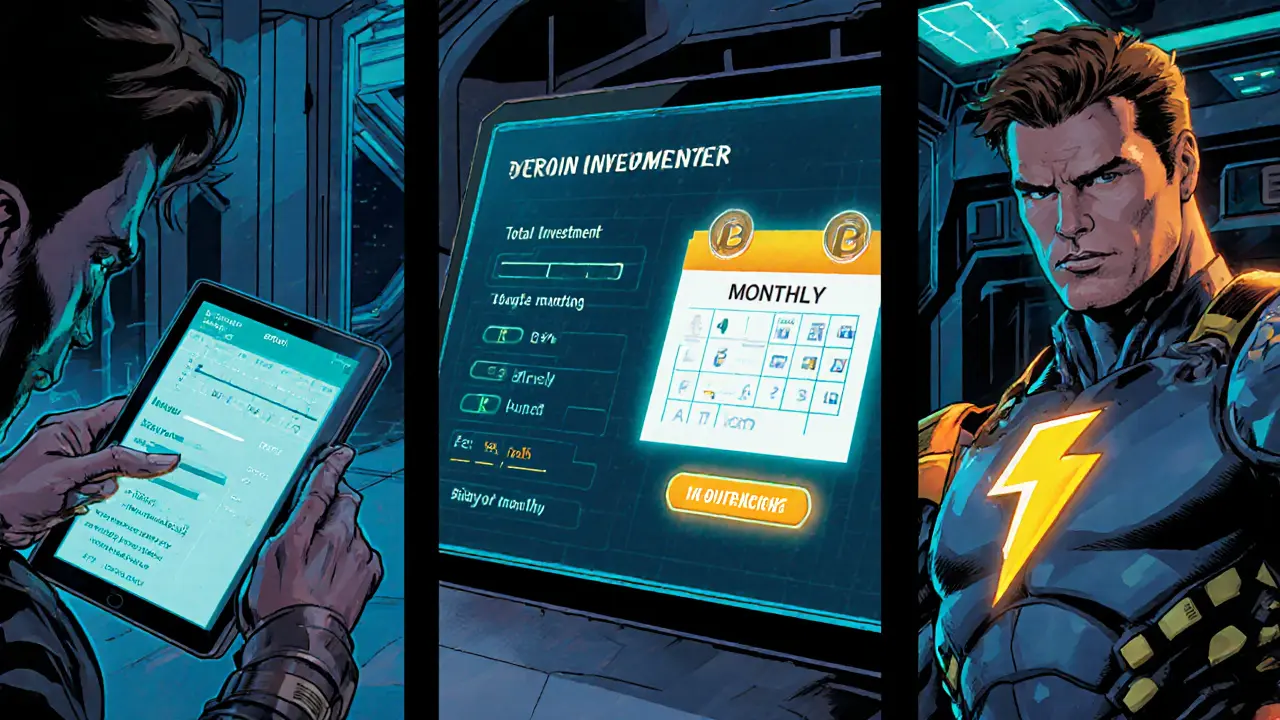Bitcoin DCA Calculator
Your DCA Investment Summary
Total Investment: $0.00
Number of Purchases: 0
Amount per Purchase: $0.00
Estimated Annual Fees: $0.00
Annual Fee Percentage: 0.00%
Recommended Frequency: Monthly
Fee Comparison Table
| Interval | Avg. Price Smoothing | Typical Fee per Trade | Annual Fee % (Estimate) |
|---|---|---|---|
| Daily | Highest | 0.25% - 0.5% | ≈180% |
| Weekly | High | 0.20% - 0.4% | ≈10-20% |
| Bi-Weekly | Medium | 0.20% - 0.4% | ≈5-10% |
| Monthly | Good | 0.15% - 0.3% | ≈2-5% |
Trying to ride Bitcoin’s wild price swings can feel like gambling, but a systematic approach can take the emotion out of the equation. A Bitcoin DCA strategy lets you buy a fixed amount of the cryptocurrency on a regular schedule, smoothing out highs and lows over time. Below is a practical roadmap that shows exactly how to set it up, what choices matter most, and how to avoid common traps.
Key Takeaways
- Divide your total budget into equal chunks and buy Bitcoin at consistent intervals.
- Pick an amount you can afford after covering living expenses.
- Choose a frequency that balances price smoothing with transaction fees.
- Use an exchange that offers automated recurring purchases and low fees.
- Stay disciplined - don’t tweak the plan based on short‑term market noise.
Understanding Dollar Cost Averaging
At its core, Dollar Cost Averaging is a systematic investment method where a fixed monetary sum is invested at regular intervals, regardless of the asset’s price. The idea is simple: when Bitcoin’s price dips, your fixed spend buys more coins; when the price spikes, you buy fewer. Over many cycles, the average cost per coin tends to settle somewhere between the market extremes, reducing the risk of a poorly timed lump‑sum purchase.
Why Bitcoin Fits the DCA Model
Bitcoin is a decentralized digital currency with a market cap over $1.2trillion (late2024) and 24/7 trading. Its price can swing 10‑15% in a single day, making timing especially hazardous for retail investors. Because Bitcoin trades continuously across time zones, a recurring schedule ensures you stay exposed without having to monitor the market around the clock.
Step‑by‑Step Setup
- Define Your Total Commitment - Decide the total amount you want to allocate to Bitcoin over a chosen horizon (e.g., $6,000 over 12months). Financial advisors recommend using money that remains after essential expenses and an emergency fund.
- Pick the Investment Interval - Common options are daily, weekly, bi‑weekly, or monthly. Weekly purchases give smoother price averaging but increase fee exposure; monthly buys cut fees but may miss short‑term dips. For most beginners, a monthly cadence balances cost and smoothing.
- Calculate the Per‑Period Amount - Divide the total commitment by the number of intervals. Example: $6,000 ÷ 12months = $500 each month.
- Select a Platform that Supports Automated Recurring Buys - Look for a cryptocurrency exchange that offers a built‑in recurring purchase feature, low transaction fees, and easy fiat‑to‑Bitcoin conversion.
- Set Up the Recurring Order - On the chosen exchange, navigate to the “Recurring Buy” or “Auto‑Buy” section, enter the fiat amount, choose Bitcoin as the asset, and confirm the schedule.
- Secure Your Coins - Transfer the purchased Bitcoin to a personal wallet you control (hardware or software) after each buy to reduce exchange custody risk.
- Monitor Fees and Adjust if Needed - Review the annual fee impact; if it exceeds 0.5% of invested capital, consider switching to a lower‑fee platform or adjusting the frequency.
Choosing the Right Frequency
Frequency directly influences two variables: price smoothing and fee accumulation.
| Interval | Avg. Price Smoothing | Typical Fee per Trade | Annual Fee % (Assuming 0.5% per trade) |
|---|---|---|---|
| Daily | Highest | 0.25% - 0.5% | ≈180% |
| Weekly | High | 0.20% - 0.4% | ≈10‑20% |
| Bi‑weekly | Medium | 0.20% - 0.4% | ≈5‑10% |
| Monthly | Good | 0.15% - 0.3% | ≈2‑5% |
For most retail investors, the monthly option offers a sweet spot: enough purchases to smooth volatility while keeping fees under a few percent of the total invested amount.

Platform Selection Checklist
- Automated Recurring Buy Feature - Must allow you to set a fixed fiat amount on a repeat schedule.
- Fee Structure - Look for platforms with 0% fees for recurring purchases (e.g., RiverFinancial) or at least sub‑0.25% rates.
- Security - Two‑factor authentication, cold‑storage options, and insurance coverage.
- Fiat Funding Options - Direct bank transfer, debit card, or ACH with minimal processing delays.
- Withdrawal Flexibility - Ability to move Bitcoin off‑exchange swiftly after each purchase.
Managing Transaction Costs
Beyond explicit fees, you’ll encounter spreads (the difference between buy and sell prices) and network fees for moving Bitcoin to your wallet. On most major exchanges, spreads hover around 0.1‑0.5%.
Strategies to keep costs low:
- Choose platforms that bundle fees into the price (zero‑fee recurring buys).
- Use the Lightning Network for small, frequent purchases - it reduces on‑chain transaction fees to fractions of a cent.
- Consolidate purchases quarterly if fees become a major drag, but be aware this reduces price‑averaging granularity.
Pros and Cons Compared to Other Strategies
| Metric | DCA | Lump‑Sum | Active Trading |
|---|---|---|---|
| Risk during volatile markets | Low - spreads cost over time | High - timing risk | Variable - depends on skill |
| Potential upside in strong bull market | Moderate - gradual exposure | High - full exposure from day1 | High - can amplify gains |
| Complexity | Very low - set‑and‑forget | Low - single transaction | High - requires analysis, monitoring |
| Time commitment | Minimal after setup | Minimal | Significant |
| Fee impact | Depends on frequency | One‑time fee | Multiple trades → higher fees |
In summary, DCA shines for investors who value consistency, lower stress, and risk mitigation over chasing the highest possible return.
Common Pitfalls & How to Avoid Them
- Letting Fees Eat Returns - Monitor the cumulative fee percentage; if it exceeds 1% of your capital annually, switch to a lower‑fee provider or reduce frequency.
- Skipping Purchases During Bear Markets - The temptation to pause buying when prices fall defeats the averaging principle. Stick to the schedule.
- Over‑Allocating to Bitcoin - Even with DCA, recommend limiting Bitcoin to a sensible portfolio share (e.g., 5‑15% of total assets) unless you have a high risk tolerance.
- Ignoring Tax Implications - In many jurisdictions, each purchase creates a new tax lot. Use platforms that provide detailed transaction reports for easier filing.
- Storing on Exchanges Indefinitely - Transfer bought Bitcoin to a personal wallet after each purchase to reduce custodial risk.
Advanced Tweaks (Optional)
If you’re comfortable with a bit of extra effort, consider these upgrades:
- Rebalancing - Periodically adjust your DCA amount to maintain a target portfolio weight (e.g., increase monthly buy if Bitcoin’s share drops below 5%).
- Tax‑Loss Harvesting Integration - Some newer platforms let you automatically sell a small portion of Bitcoin at a loss to offset gains elsewhere.
- Multi‑Asset DCA - Allocate a portion of each recurring purchase to other crypto assets (Ethereum, stablecoins) while keeping Bitcoin as the core holding.
Next Steps Checklist
- Calculate a realistic total Bitcoin budget.
- Choose a monthly purchase amount that fits your cash flow.
- Pick an exchange with zero‑fee recurring buys (e.g., RiverFinancial, Kraken).
- Set up the automated order and enable two‑factor authentication.
- Transfer each purchase to a hardware wallet within 48hours.
- Review fees quarterly; adjust frequency if needed.
- Keep the plan simple - no changes based on daily price moves.

Frequently Asked Questions
Is DCA suitable for a small budget?
Yes. Because each purchase is small, fees become the critical factor. Look for platforms offering zero‑fee recurring buys or use the Lightning Network to keep costs below 0.1% of each trade.
How long should I run a Bitcoin DCA plan?
Treat it as a long‑term strategy. Most experts recommend at least 3‑5years to let the averaging effect smooth out multiple market cycles.
Can I change the amount or frequency later?
Yes, most exchanges let you modify recurring orders on the fly. However, avoid frequent changes, as they can undermine the discipline that makes DCA effective.
What are the tax implications of regular Bitcoin purchases?
Each purchase creates a new cost basis. When you eventually sell, you’ll need to calculate gains or losses for each lot. Many platforms now provide CSV reports that simplify year‑end filing.
Should I keep my Bitcoin on the exchange?
For security, transfer bought Bitcoin to a personal wallet you control. Exchanges are convenient for buying, but they hold the private keys, exposing you to hacking or insolvency risk.


Angie Food
May 9, 2025 AT 18:14Who needs a DCA calculator when the market's a casnio anyway?
Jonathan Tsilimos
May 18, 2025 AT 10:34The outlined methodology integrates stochastic averaging techniques to augment portfolio rebalancing efficiency. It adheres to quantitative risk mitigation protocols.
jeffrey najar
May 27, 2025 AT 02:54Alright, let’s break this down step by step so you can actually use the calculator without feeling lost.
First, decide how much capital you’re comfortable allocating over the chosen period – think of it as your “budget” for the experiment.
Second, pick a realistic timeframe; most people go for 6‑12 months when they’re testing a DCA approach.
Third, choose a purchase frequency that matches your cash‑flow – weekly or bi‑weekly usually balances convenience and price smoothing.
Now, plug those numbers into the tool – you’ll see the total number of purchases and the average amount per trade pop up instantly.
Don’t ignore the fee column: even a 0.2% fee compounds over dozens of trades, so lower‑frequency plans can save you a few bucks in the long run.
Once you have the summary, compare the “Estimated Annual Fees” against your expected returns; if fees are eating up most of your profit, consider a higher‑interval cadence.
Remember, DCA works best in volatile markets because it smooths out price spikes, but it won’t protect you from a prolonged downtrend.
If you’re bullish on Bitcoin, a monthly plan with a modest fee (≈2‑5%) is usually a sweet spot.
Conversely, if you’re a risk‑averse trader, weekly purchases with a tighter fee window (≈10‑20%) may feel safer, albeit more expensive.
Another tip: many exchanges offer fee discounts for higher volume or native token usage – factor that into your calculations.
Also, watch out for hidden costs like withdrawal fees; they’re not always displayed in the calculator but can erode returns.
Finally, treat the tool as a guideline, not a gospel – adjust parameters as your financial situation evolves.
Keep records of each purchase so you can later analyze performance versus the projected numbers.
In summary, set clear capital limits, choose a frequency that matches cash flow, mind the fees, and revisit the plan regularly – that’s the essence of a solid Bitcoin DCA strategy.
Rochelle Gamauf
June 4, 2025 AT 19:14While the presented framework is ostensibly comprehensive, it regrettably glosses over the nuanced interplay between market microstructure and fee tiering, an omission most discerning investors will find untenable. The purported "good" smoothing at monthly intervals merely reflects a veneer of prudence, lacking the rigor demanded by sophisticated portfolio theory. Moreover, the fee table's approximation of annual percentages is a stark oversimplification that fails to account for tiered fee schedules prevalent among major exchanges. One must therefore approach this guide with a measure of circumspection, lest one be lulled into a false sense of security.
Jerry Cassandro
June 13, 2025 AT 11:34Nice breakdown! One thing to add: if you’re using an exchange that offers zero‑fee trading for certain assets (like some of the newer platforms), you can essentially eliminate the fee concern altogether. Just make sure the platform is reputable and that you’re comfortable with the custody risks.
Parker DeWitt
June 22, 2025 AT 03:54🤔 Sure, but you’re just ignoring the fact that daily DCA will bleed you dry on fees. If you *really* want to stack sats, go weekly and keep the wallet on‑chain – crypto‑nationalism says keep it sovereign! 🚀
Allie Smith
June 30, 2025 AT 20:14Yo, DCA is like planting seeds – you don’t need to water every single day, just be consistent and you’ll see the trees grow. Chill vibes, keep it simple.
Lexie Ludens
July 9, 2025 AT 12:34Ugh, another "step‑by‑step" guide that pretends to be helpful but really just rehashes the same old hype. Honestly, if you’re not willing to sit on your hands for months, you’ll never learn anything. 🙄
Aaron Casey
July 18, 2025 AT 04:54The utilization of a DCA schema inherently reduces exposure to systematic volatility, thereby aligning with modern portfolio theory's risk‑adjusted return objectives. Incorporating transaction cost analysis into the frequency decision matrix is essential for optimal capital efficiency.
Leah Whitney
July 26, 2025 AT 21:14Great advice! If you’re new, start with a modest amount and maybe set a weekly reminder so you don’t forget. Consistency beats timing.
Lisa Stark
August 4, 2025 AT 13:34From a philosophical standpoint, DCA mirrors the notion of patience in the face of uncertainty – a lesson as timeless as any ancient teaching.
Logan Cates
August 13, 2025 AT 05:54Yeah, sure, follow the guide. Meanwhile, the big banks are secretly pulling the strings, so any strategy is moot. Just don’t trust the system.
Shelley Arenson
August 21, 2025 AT 22:14👍 Looks solid! Thanks for sharing.
Joel Poncz
August 30, 2025 AT 14:34Hey there, just wanted to say the guide is pretty clear. If you have any trouble with the calculator, feel free to ask.
Kris Roberts
September 8, 2025 AT 06:54Nice, I’m gonna try the monthly plan. It seems chill and low‑effort.
lalit g
September 16, 2025 AT 23:14I appreciate the balanced approach. It’s important to stay calm and avoid over‑reacting to short‑term price swings.
Reid Priddy
September 25, 2025 AT 15:34Honestly, this whole DCA hype is just another way for the elite to keep you buying into the system. You’re better off hoarding cash.
Shamalama Dee
October 4, 2025 AT 07:54Thanks for the thorough guide. It’s written clearly and provides actionable steps for beginners and seasoned investors alike.
scott bell
October 13, 2025 AT 00:14Cool tool! I’m curious about how the fee estimates change if you switch from a centralized exchange to a decentralized one – any thoughts?
vincent gaytano
October 21, 2025 AT 16:34Oh great, another spreadsheet to convince you that the “system” works. Meanwhile, the real truth is hidden behind layers of code nobody reads. 😂